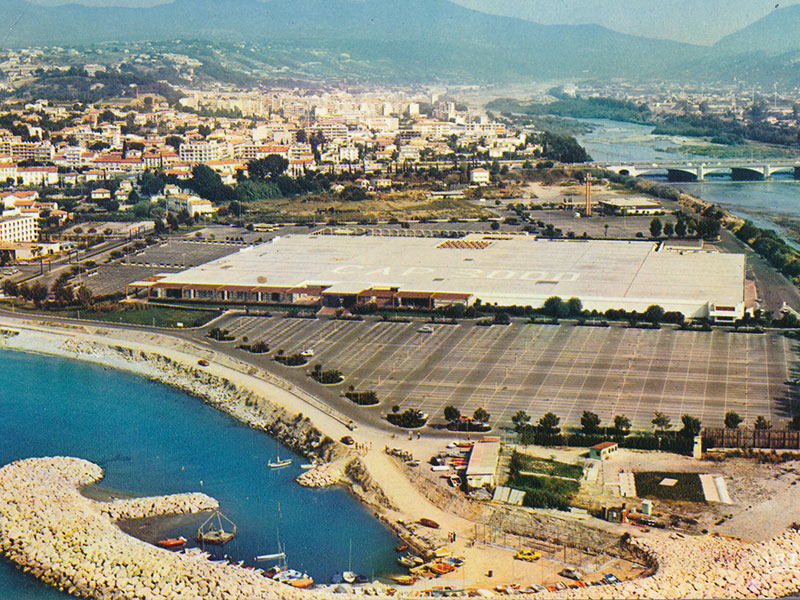Half a century is a long period of time, especially in the real estate world. It is, therefore, all the more remarkable that in October 1969, Cap3000, the first shopping center in France, was opened in Saint-Laurent-du-Var, near Nice. The “3000” in the name, incidentally, refers to the number of parking spaces offered at that time. Today, there are 4,200. In 2010, Altarea Cogedim, in collaboration with its partners ABP and Predica, purchased the mall from the Galeries Lafayette Group. “At that time, the acquisition fully displayed our ability to position ourselves in the regional shopping center market. That was completely in line with our strategy, which is grounded in our ability to create value by managing and developing such assets. Almost a decade later and after several phases of expansion and renovation, we are confident we made the right choice,” explained Alain Taravella, Chairman and Founder of Altarea Cogedim.

“Oceans” among the New Tenants
These days, Cap3000 is a new-generation center, a “living space” that offers customers and visitors special experiences. It is now comprised of more than 135,000 sq m and boasts an enhanced commercial, cultural, and leisure offering. In addition, CAP3000, with its seafront location that encapsulates the Côte d’Azur, is within easy reach of the Nice airport.
A 70,000-square-meter extension has recently been opened. As previously indicated, Cap3000 now covers 135,000 sq m. The number of shops and restaurants has increased from 180 to 250. One of the new tenants is “Oceans”, which allows visitors to virtually dive into the sea and be surrounded by fish. The “Oceans” program focuses on respect for biodiversity and natural ecosystems. Its purpose is to allow viewers to explore the depths of the sea without disturbing its magnificent, but fragile, ecosystem. Working in partnership with the Oceanographic Museum of Monaco, Altarea Cogedim chose to house the novel aquarium, which allowed Cap3000 to become the world’s first shopping center to earn biodiversity certification. Such certification promotes the design and construction of new buildings that give special priority to nature in an urban setting.
The Transformation
Over the last 50 years, the mall has, of course, been architecturally optimized on a regular basis. Naturally, the updates have resulted in the removal of the low ceilings and the enormous and austere building that once stood surrounded by a sea of cars. Architects from Groupe-6 have finally managed to help reinvent Cap3000 as a 21st-century shopping center. In 2014, internationally renowned designers Patrick Jouin and Sanjit Manku accepted Altarea Cogedim’s invitation to revamp the indoor spaces and furnishings. Well-versed in interior design for high-end shops, hotels, and restaurants, the duo tackled its first project of such a large scale intended for the general public. Working with the natural light streaming into the mall, they adorned the glass roofs with upside-down boats made of a warmly-tinted wood that emphasizes the gentle curvature. Atelier H. Audibert, a lighting designer, fashioned an installation to greet customers at the Porte de Nice (Nice entrance): Organic shapes float in space and portray what is known as “marine snow”.
All of the art installations were designed by and developed for CAP3000. Inspired by the Jouin Manku interior design movement, marine motifs and fluidity, all of the selected artists are focused on the passion of handicraft. The works were created in the artists’ own workshops and were handmade using traditional techniques, such as glass-blowing, hand-polishing, haute couture fabric pleating, etc. A sculpted playground and two outdoor illuminated creations can be found along the seafront and inside the shopping center. The expansion houses “L’odyssée des Abysses” by Studio Marianne Guély, whose airborne sculptures call to mind a dive into deep water. The work’s abstract, pleated shapes exalt the poetry of the marine world.
For the walkway, Polish artist Mirek Struzik of Curation Artbliss fashioned “Bubble Forest” and “Dandelions”, two works created on the basis of delicate, natural plant shapes. “Bubble Forest” was created as a free-flowing meditation on the ability of plants to produce oxygen. “Dandelions” is an installation that draws its inspiration from the sophisticated structure of natural dandelions. Finally, the second floor is home to “Polymorphe Bleu”, a piece of artwork intended to energize and welcome children. This sculpture, which was designed by the husband-and-wife team of Jean Marie and Marthe Simonnet, was inspired by the sea and the Mediterranean coast.
Work has already begun on the next expansion: A high-end area featuring 30 premium and luxury shops is scheduled to open its doors at Cap3000 in 2020.






